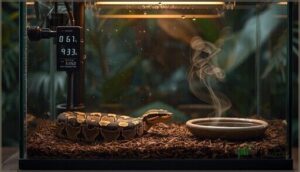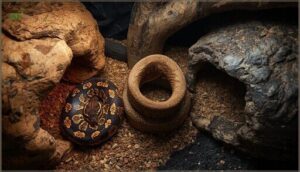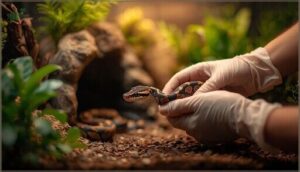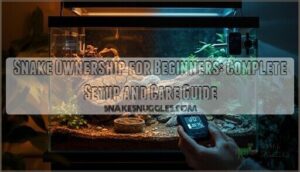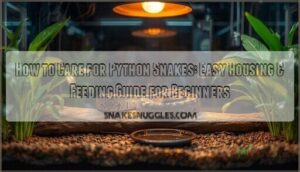This site is supported by our readers. We may earn a commission, at no cost to you, if you purchase through links.

Your new ball python is coiled in its shipping container, and suddenly you’re second-guessing everything. Did you get the right substrate? Is that corner too close to the window? Research shows ball pythons hide 27% more often in homes with constant noise and activity—they’re reading your environment from the moment they arrive.
The difference between a thriving snake and one that refuses food for months often comes down to decisions you make before opening that container. Getting your home ready isn’t about buying the fanciest equipment or creating an Instagram-worthy setup. It’s about understanding what your snake actually needs to feel secure, and then building that environment with precision and care.
Table Of Contents
Key Takeaways
- Your ball python needs a quiet, low-traffic spot at least 10 feet from TVs or speakers since studies show they hide 27% more in noisy environments, and this location choice directly impacts their willingness to eat.
- You’ll need to create a temperature gradient with a warm side at 88-92°F and a cool side at 75-80°F, plus maintain 50-60% humidity (70-80% during shedding) to prevent respiratory issues and shedding problems.
- At least two snug hides—one on each temperature side—are essential since ball pythons spend over 60% of daylight hiding, and proper hide placement directly affects feeding response and stress levels.
- Enclosure security matters more than you think: over 80% of escapes happen without proper locks, so you need dual-latching lids or cable clamps to prevent your snake from disappearing for good.
Preparing Your Home for a Ball Python
Before you bring your ball python home, you’ll want to make sure everything’s ready. A little prep work now means less stress for both you and your new snake later.
Let’s walk through the key steps to get your space set up right.
Choosing a Safe and Quiet Location
Before you begin habitat setup, find a spot that’s calm and steady. Ball pythons are sensitive to vibrations and noise—studies show they hide 27% more when exposed to frequent activity. Choose a low-traffic room at least 10 feet from TVs or speakers.
Avoid direct sunlight and drafts, which disrupt temperature stability and humidity management. A quiet location reduces stress and aids in proper enclosure size function for ideal ball python care.
Proper temperature control is essential, and understanding ambient humidity levels is vital for creating a suitable environment.
Child and Pet Safety Considerations
If you have kids under five or other pets, exotic pet ownership requires extra care. The CDC links reptiles to over 74,000 annual salmonellosis cases—zoonotic disease risk is real. Always wash hands after handling and never let children kiss your snake.
Pet interaction risks include cats injuring escaped pythons or defensive bites. Child supervision is non-negotiable. Secure lids prevent snake escape prevention failures, protecting both animal welfare and household hazards from turning serious.
It’s vital to understand reptile health risks to create a safe environment for your family.
Gathering Essential Supplies
Once your home is secure, you’ll need the right gear. Here’s your pre-arrival checklist:
- Enclosure Size: 20-30 gallons for juveniles, 40+ for adults
- Heating Equipment: Heat pads or ceramic emitters with thermostats (under $30 for monitors)
- Substrate Options: Newspaper, bark mulch, or coconut fiber ($10–$20 per bag)
- Hides Selection: Minimum two snug shelters ($15 each), plus water bowls and feeding tongs
Smart planning prevents expensive mistakes later.
Selecting The Ideal Enclosure
Your ball python’s enclosure isn’t just a tank—it’s their entire world. Getting the size and setup right from the start will keep your snake comfortable, secure, and stress-free as they grow.
Let’s walk through what you need to know about choosing the perfect home for your new companion.
Recommended Tank Sizes by Age
Your ball python’s enclosure size should grow right alongside them. Hatchlings do well in 10-gallon tanks, while juveniles need 20-30 gallons as they stretch past two feet. Once your snake hits three feet, upgrade to 40 gallons.
Adults require at least a 4x2x2-foot setup—that’s 75+ gallons—to move comfortably and stay healthy.
Enclosure Material Options
Your reptile enclosure setup deserves careful thought—each material brings distinct PVC benefits and trade-offs. Here’s what you need to know:
- PVC enclosures retain humidity 30% better than glass tanks, keeping your python’s skin healthy during sheds.
- Glass terrariums offer crystal-clear viewing but lose heat 60% faster, driving up electricity costs.
- Wooden vivariums and HDPE enclosures provide excellent insulation, though wood requires resealing every 2-3 years to prevent mold.
Acrylic options split the difference—lighter than glass, clearer than plastic.
Importance of Secure Lids and Locks
Without proper lock mechanisms, over 80% of ball python escapes happen—and most snakes vanish for good. You need secure enclosures with dual-latching lids for tanks over 3 feet. Snap-on screens won’t cut it. Invest in vivarium cable locks or combination clamps to reduce escape prevention failures by 95%.
Over 80% of ball python escapes happen without proper locks—dual-latching lids and cable clamps reduce failures by 95%
Check your lid designs weekly, because your snake’s pushing against weak points right now.
Setting Up The Habitat
Once you’ve picked the right enclosure, it’s time to turn that empty box into a comfortable home your ball python can actually thrive in. Getting the habitat details right from the start makes a huge difference in your snake’s health and stress levels.
Let’s walk through the essentials you’ll need to set up before bringing your new pet home.
Creating a Temperature Gradient
Think of your ball python’s enclosure as a house with distinct climate zones—that’s what a proper thermal gradient does. You’ll need a basking spot around 88°F to 92°F on the warm side and 75°F to 80°F on the cool side.
Use overhead heating options like ceramic heat emitters or halogen bulbs paired with thermostats for safe temperature control and natural thermoregulation throughout the habitat setup.
Maintaining Proper Humidity Levels
Getting humidity right isn’t optional—it’s critical for your ball python’s respiratory health and successful shedding. You’ll want to maintain 50-60% humidity normally, bumping it to 70-80% during sheds.
Here’s your humidity management checklist:
- Install a calibrated digital hygrometer near substrate level for accurate readings
- Place water bowls on the warm side to boost humidity through natural evaporation
- Choose moisture-retaining substrate like cypress mulch or coconut husk
- Monitor ventilation carefully—seal excess airflow without restricting oxygen exchange
Choosing and Arranging Hides
Your snake’s hides aren’t just décor—they’re essential for stress reduction and health. You need at least two hides: one on the warm side (88-90°F) and one on the cool side for proper thermal regulation.
Ball pythons spend over 60% of daylight hours hiding, so proper habitat setup with appropriately sized hide options directly impacts feeding response and overall wellness.
| Hide Feature | Best Practice |
|---|---|
| Size | Snug fit—just slightly larger than your snake |
| Placement | One warm-side, one cool-side thermal hide |
| Design | Single entrance, opaque materials |
| Number | Minimum two; three or more reduces stress indicators |
Choose opaque hide materials like cork bark or resin that sit directly on substrate.
Selecting The Right Substrate
Substrate selection goes beyond aesthetics—it’s a health decision. You’re choosing what regulates humidity control, ammonia absorption, and facilitates natural burrowing behavior in your ball python’s habitat setup.
Consider these substrate options for excellent reptile care:
- Coconut fiber/coir: Excellent humidity retention (70-80%) and odor management
- Cypress mulch: Facilitates moisture release and burrowing behavior
- 70/30 topsoil/sand blend: Natural substrate selection for enrichment
- Avoid corncob: Poor ammonia absorption increases respiratory risk
Water Bowl Placement and Size
Your water bowl placement directly impacts snake hydration and humidity control. Position it on the cool side—72% of keepers do this to prevent rapid evaporation while stabilizing moisture levels in your enclosure setup.
| Age Group | Bowl Capacity | Diameter | Depth |
|---|---|---|---|
| Hatchlings (<6 months) | 150ml minimum | 8-10 cm | 3-4 cm |
| Juveniles (6-12 months) | 250-350ml | 10-12 cm | 3-4 cm |
| Adults (12+ months) | 500ml+ | 15+ cm | 3-4 cm |
Choose ceramic or resin bowl materials—they harbor 45% fewer bacteria than plastic options, protecting water quality through daily changes.
Introducing Your Ball Python Safely
Bringing your ball python home is exciting, but the first few days are critical for building trust and preventing stress. How you handle those early moments sets the tone for your relationship with your snake.
Let’s walk through the safest ways to help your new pet settle in and when it’s okay to start handling.
Minimizing Stress During Transition
Your new ball python needs time to decompress—usually 1–2 weeks of acclimation without handling. Environmental consistency is key: maintain that temperature gradient (88–92°F warm side, 76–80°F cool) and humidity control between 60–75%. Resist the urge to peek constantly. Stress reduction happens when you let your snake settle in quietly.
Feed refusal drops dramatically when you follow these adjustment strategies and respect the acclimation period.
First Handling Tips for New Owners
Once your ball python has eaten that first meal, wait 48–72 hours before attempting any handling. Use both hands to support the body—never grab from above. Start with 5–10 minute sessions, approaching from the side.
Watch for defensive signals: tight curling, hissing, or rapid breathing mean it’s time to stop and try again tomorrow.
Ongoing Care and Health Maintenance
Once your ball python is settled in, the real work begins—and honestly, it’s not that hard if you stay consistent. Your snake’s long-term health depends on proper feeding, recognizing when something’s off, and keeping their space clean.
Let’s walk through the essential routines that’ll keep your python thriving for years to come.
Feeding Schedules and Nutrition
Getting your feeding schedule right is one of the most critical pieces of pet snake ownership. For proper digestive health, you’ll want to feed hatchlings every 5 days, juveniles weekly, and adults every 10-14 days.
Prey selection matters too—match meal sizing to your python’s girth, never exceeding it. This nutrient balance approach promotes ideal snake health and wellness for ball python care and maintenance.
Monitoring Shedding and Assisting if Needed
Vigilance during your ball python’s shed cycle prevents most shedding problems before they start. You’ll notice dull scales and cloudy eyes 7-14 days before ecdysis—boost humidity control to 70-80% immediately.
Watch for retained skin or dysecdysis after completion. If you spot stuck patches, a shallow soak and gentle assistance with handling tips from your reptile vet prevents escalating health issues in snake care.
Cleaning and Hygiene Practices
Consistent enclosure sanitation protects your snake from infectious agents like Salmonella. Spot-clean feces 2-3 times weekly, and perform complete disinfection with reptile-safe cleaners or 3% bleach solution every seven days. Replace substrate every 10-12 weeks based on humidity and soiling.
Clean water bowls daily using disposable gloves—never in kitchen sinks. These hygiene tools and cleaning schedules form the foundation of disease prevention in reptile husbandry.
Recognizing Signs of Illness
Early detection saves lives—nearly 60% of captive pythons develop respiratory issues, while neurological signs like head tremors affect many more.
Watch for feeding problems lasting over a month, shedding abnormalities in low humidity, lethargy, or unexplained weight loss. These common health issues in ball pythons require immediate veterinary attention.
Regular health monitoring through consistent observation is your best defense in proper reptile husbandry and snake care.
Frequently Asked Questions (FAQs)
What are the average costs of different ball python morphs?
Ball python costs are like a sliding scale—entry-level morphs like Clowns start around $79, while ultra-rare varieties like Scaleless hets can hit $45,000, depending on breeder fees and market trends.
How do I choose a reputable breeder or seller?
You’ll want a breeder who provides health guarantees, detailed records, and actual photos of their ball pythons.
Check online reviews carefully—sellers with facility tours and veterinary documentation are your safest bet.
Can ball pythons recognize or bond with their owners?
Despite your best efforts, research shows ball pythons don’t recognize individual owners or form emotional bonds. They rely on routine and scent patterns for familiarity, not social attachment like mammals do.
What is the typical lifespan of a ball python?
With proper captive care, your ball python can live 20 to 30 years—some even reach 40 or beyond. Wild survival averages just 10 to 15 years due to predation and habitat challenges.
Do ball pythons require UVB lighting in captivity?
While they can survive without it, UVB lighting benefits your ball python’s health—supporting vitamin D3 production and immune function.
Use low-intensity fixtures mimicking natural exposure, maintaining proper lighting schedules and UVB safety precautions for ideal reptile care.
Conclusion
Your ball python’s success hinges on one thing: whether you’ve built trust before that first interaction. Every corner you’ve secured, every temperature you’ve checked, every quiet hour you’ve given them—it all compounds.
Introducing ball pythons to home environments isn’t dramatic. It’s methodical. It’s patient. And when you get it right, you won’t just own a snake. You’ll have a calm, feeding, thriving animal that actually wants to emerge from its hide.
- https://a-z-animals.com/blog/ball-python-prices-purchase-cost-supplies-food-and-more/
- https://www.reddit.com/r/ballpython/comments/ywum2j/i_made_a_bare_minimum_basic_guide_for_beginners/
- https://www.youtube.com/watch?v=te48P2Ilq5M
- https://pmc.ncbi.nlm.nih.gov/articles/PMC6021098/
- https://community.morphmarket.com/t/on-ball-python-cohabitation/11022



